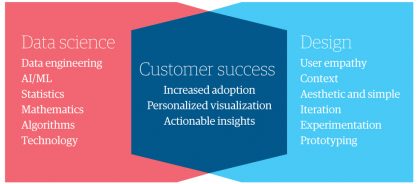- Point of view
Customer experience strategy
Fuse data and design to seize the D2 advantage

Today's organizations are increasingly data-driven. Data scientists are putting their skills in mathematics, statistics, and engineering to work. They're building sophisticated analytics models using powerful technologies like artificial intelligence (AI) and machine learning to make recommendations enhanced by human judgment. This is known as augmented intelligence, and it's helping businesses make faster and more informed decisions.
But now, we're entering the next phase of the experience economy. Leading companies – whether they sell to consumers or businesses – will find that the next competitive battleground lies in creating memorable experiences not just for customers, but employees and partners too. As a result, data alone is not enough. Businesses must apply a dual lens of data and experience design – also known as D2 – to drive innovation and meet user demands.
D2 fuses smart data strategies with a design-led approach focused on empathy and an understanding of user needs. This combination supports highly personalized experiences, which address user needs in ways that neither data nor experience design can alone. Some of the most successful organizations in the world – such as Apple, Amazon, and Google – take a D2 approach. And more traditional sectors – like banking, insurance, consumer packaged goods, and healthcare – are following suit.
D2 in action
For D2 to be successful, qualitative and quantitative research must work together. Qualitative data provides insights that are seldom revealed through interviews or workshops. Conversely, data analysis may not uncover qualitative insights. For instance, user-based research gives organizations confidence that proposed changes will be adopted, while qualitative data provides objective insights that can help detect or diagnose hidden problems.
For example, Netflix combines content performance data with an understanding of user behavior to create better experiences. If a user favors a certain actor or genre, Netflix will push associated content to the top of their feed. It even suggests content based on what the user prefers to watch at certain times of day.
This user-centric approach works in the business world, too. Working with a Genpact team, a financial services client sought to improve its customer experience by redesigning its loan application process. A root-cause analysis through site visits, workshops, and employee interviews – combined with timestamp data from its loan-processing system – allowed the team to identify wait times, quantify exceptions, and understand factors influencing approvals. This combination of human research and quantitative data revealed where the customer and employee experience was suffering. Based on the insights collected from the D2 approach, the client was able reduce the length of the loan process, from 13 days down to just two days.
At the intersection of D2, synergies emerge that support smarter and more timely decisions that delight customers, employees, and partners alike.
Fuse data and design to seize the D2 advantage

D2 guiding principles
To fuel a D2 approach, apply guiding principles as part of a holistic experience-led transformation that spans a comprehensive customer experience strategy, design, and engineering plan. Here's some pointers to get you started:
Open the aperture: When analytics projects fall short, data scientists often look at adjusting analytical models. However, the problem may not be the algorithms, but the understanding of user needs using advanced customer experience analysis tools. A few years ago, Google published display ads to the right of search results. And although this was somewhat successful, Google wanted to boost click-through rates by better understanding user behavior. After conducting some customer experience design experiments, Google embedded ads directly into search results, mapping them to a user's natural way of searching. As a result, click-through rates increased. So although the models were using data correctly, without design thinking, its success was limited – this is the power of D2.
Consider your personas: A successful customer experience strategy, or CX strategy, starts with a focus on what matters to customers. This information helps to design analytical models that avoid a one-size-fits-all mentality. Then, organizations can design superior, personalized, and contextualized experiences that maximize the value of data science and design thinking.
Don't make assumptions: Design thinking often reveals unexpected user needs because field research can have a significant impact on data-based insights. For example, one global pharmaceutical client worked with Genpact to develop an analytics dashboard for its marketing team. Designers and data science experts worked together to build a solution based on user research and insights. The new design was a huge success even though it was far from what the client initially had in mind. This is because the dashboard was built on quantitative data and qualitative user insights that they couldn't previously access. Without the power of D2, the dashboard may have missed some essential end user requirements.
Include end users in the process: Data initiatives are often imposed on users, with top-down expectations of adoption.
Ideally, users will embrace data initiatives without persuasion. Conducting customer experience design workshops ensures that solutions meet customer expectations and are easy to use. A design-led approach connects multi-disciplinary teams to foster collaboration. This helps people to understand how models were built, and the rationale behind recommendations. Including people in this process creates a sense of ownership that naturally leads to adoption and acceptance. And, when you overlap subject matter expertise, you'll spark the kind of innovation that only a D2 approach can ignite.
Mitigate unconscious bias: Unconscious bias is an unfortunate reality of data initiatives. Biases originate in data capture, configuring parameters, and model development. Think of the media attention surrounding Apple Card's algorithm, which assigns higher credit limits to men over women. Fortunately, design methodologies can help mitigate such biases. Building a data journey map can help you see how a business chooses to process, store, modify, analyze, and consume data to spot potential bias. And although this may not eliminate bias, it will reduce it.
Trust the process: Be open to organic discovery from both a data and design perspective. Remember, the process will be iterative, not linear. To continually improve and constantly deliver the best next experience, rely on a flow of data and human insights. Don't shy away from the inevitable tension that will surface when bringing data and design teams together. Leaders will accept this tension and work through it.
Ultimately, a D2 approach combines the best of two powerful disciplines – data and design – to help organizations think and work in new ways. In the next phase of the experience economy, those that adopt a D2 approach as part of a larger experience strategy will outshine the competition.
This point of view was co-authored by Amaresh Tripathy, Analytics Business Leader, Genpact, and Shyam Natarajan, Vertical Leader - Customer Experience, Genpact